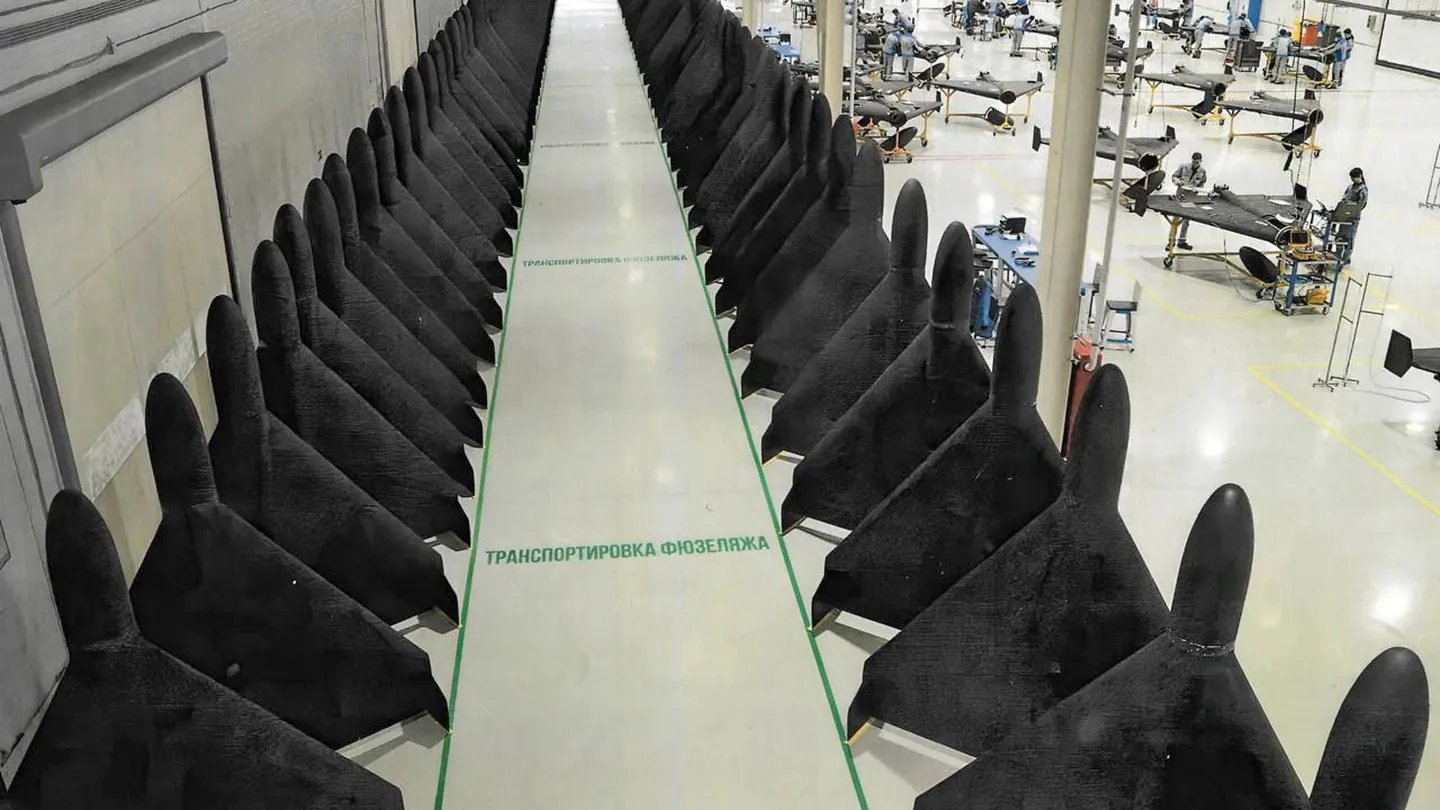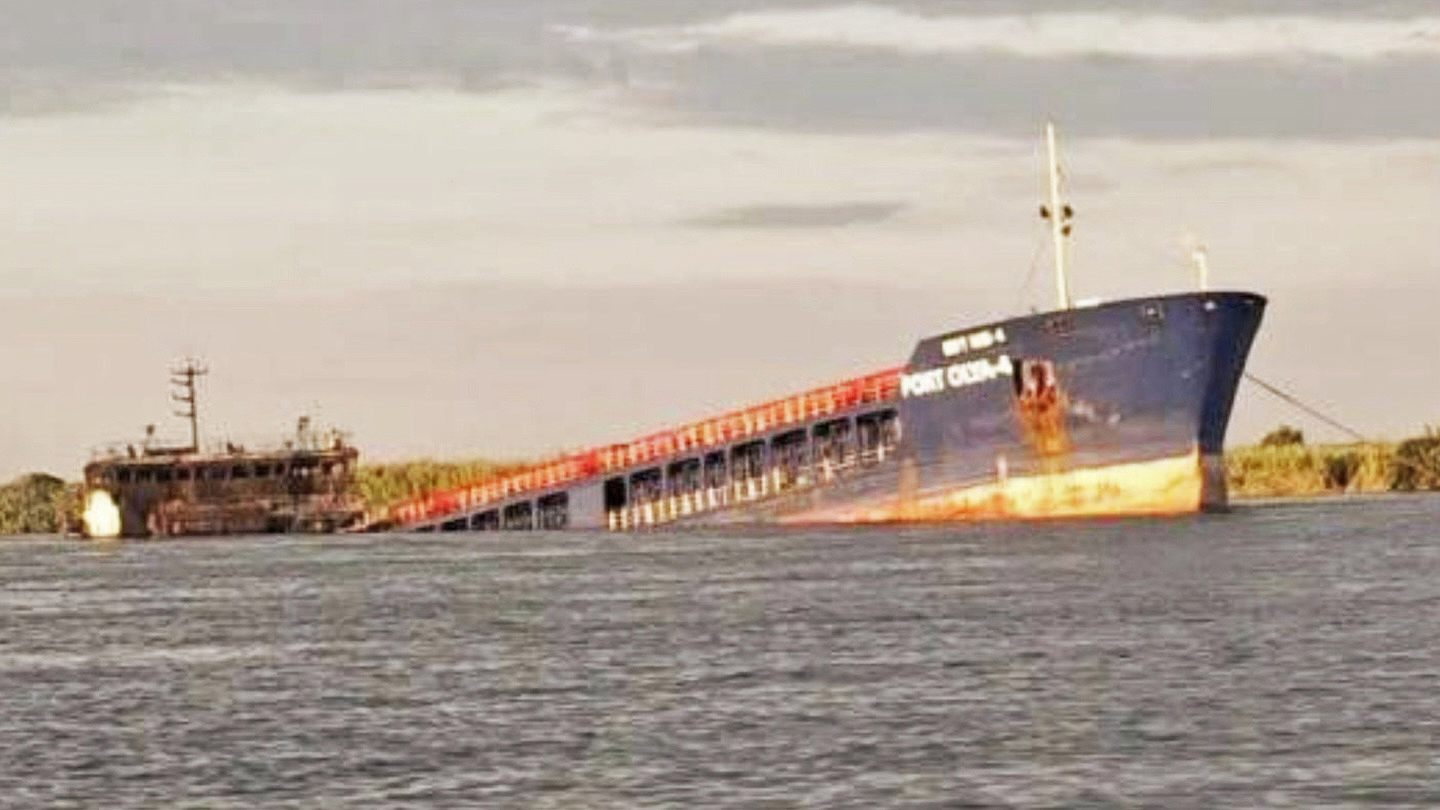Ukraine has carried out an audacious drone strike on the Caspian Sea port of Olya, in Russia’s Astrakhan region, hitting one cargo vessel that Kyiv says was being used to transport arms from Iran. U.K.-based maritime security firm Ambrey confirmed to TWZ that this is the first time a direct attack of this kind had been made on Olya and that it resulted in one ship sunk. It also appears to be the first time that Ukraine has successfully targeted any kind of vessel in the Caspian Sea area.
According to the Ukrainian military, the attack on Olya yesterday was carried out by units of the country’s special operations forces, in coordination with other branches of the armed forces.
The cargo vessel that was hit was the 400-foot-long, 4,900-gross-ton Port Olya-4, and imagery from the port shows the ship partially submerged, while it was alongside at anchor. Extensive scorch marks on the bridge and superstructure of the Russia-flagged vessel suggest that this was the likely point of impact. Unconfirmed reports, relayed by Ambrey, suggested that all of the crew had been rescued.
The Ukrainian military said the Port Olya-4 was being used to carry drone components and ammunition from Iran. The drone components reportedly included parts for the Shahed-type drones that Russia has employed heavily in its regular strikes on Ukraine. Russia is now building more than 2,000 of these long-range one-way attack drones each month, with that number only expected to grow in the coming months.
 Dating from early 2024, a first look inside the Russian factory where license production of the Iranian Shahed-series one-way attack drone is taking place. via X
Dating from early 2024, a first look inside the Russian factory where license production of the Iranian Shahed-series one-way attack drone is taking place. via X
While the precise nature of the cargo cannot be confirmed at this point, both the U.S. Treasury Department and Ukrainian military intelligence report that the vessel regularly transits the Caspian Sea, bringing cargo between Iran and Russia.
Last September, the U.S. Treasury and State Department imposed sanctions on ships and shipping firms it said were involved in supplying Russia with Iranian weapons.
It’s unclear what kind of drone Ukraine used to target the port, with no clarification from the Ukrainian military on this point. Kyiv has relied heavily on drones for long-range attacks against targets in Russia and occupied Crimea.
The Russian Ministry of Defense said it had shot down an undisclosed number of Ukrainian drones over nine regions, although it did not mention that any were brought down over the Astrakhan region. However, the Russian defense ministry did say that one Ukrainian drone was downed over neighboring Kalmykia.
 The approximate location of the port of Olya, more than 400 miles from the nearest Ukrainian border. Google Earth
The approximate location of the port of Olya, more than 400 miles from the nearest Ukrainian border. Google Earth
Subsequently, Russian authorities confirmed a drone attack on Olya. The governor of the Astrakhan region stated that all the drones had been “suppressed by electronic warfare or destroyed [and] no damage was caused to the port infrastructure… [but] a ship was damaged by debris from a downed UAV.”
This year, Ukraine has maintained a steady tempo of long-range drone strikes against Russia, with a particular focus on oil refineries and other energy infrastructure.
However, ports have also been important targets.
According to the Ukrainian military, ports and terminals account for seven percent of its successful strikes on Russian territory since the start of the year.
As well as the port of Olya, Ukrainian forces also struck the Syzran oil refinery in Russia’s Samara region overnight, which produces a range of fuels and belongs to oil company Rosneft.
In a statement on the Telegram messaging app, the Ukrainian Armed Forces said the attack on the Syzran refinery led to a fire and explosions.
Samara’s regional governor confirmed that a drone attack caused a fire at an unspecified “industrial enterprise” in his region, but claimed that it had been put out quickly.
The timing of these latest strikes is notable, coming hours before the summit between U.S. President Donald Trump and his Russian counterpart, Vladimir Putin, in Alaska. The two leaders will be discussing the war in Ukraine, but Ukrainian officials have not been invited.
As for the latest attack on Olya, it is also significant for the apparent targeting of a single vessel, a comparatively very rare direct Ukrainian attack on a merchant ship. It appears that Ukraine attacked a particular ship known to be carrying drone parts, making it a very high-priority target and reflecting the reality that, as of now, the Shahed series is by far the most important method by which Russia launches long-range strikes into Ukraine. It had long been expected that Ukraine might start to target vessels running arms deliveries from Iran to Russia, and this has now become a reality. Together with expanded long-range drone technology, we may now see a systemic interdiction campaign against these vessels.
Also important is the fact that this is the first known instance of Ukraine sinking a vessel in the Caspian Sea, extending its operations into a new area.
Regardless, the operation underscores Ukrainian efforts to undermine Russia’s devastating long-range drone strikes, which now include prosecuting key logistics hubs used for importing military supplies from Iran.
Contact the author: thomas@thewarzone.com
Thomas is a defense writer and editor with over 20 years of experience covering military aerospace topics and conflicts. He’s written a number of books, edited many more, and has contributed to many of the world’s leading aviation publications. Before joining The War Zone in 2020, he was the editor of AirForces Monthly.
